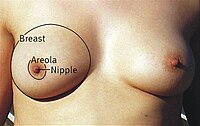
Photo from wikipedia
BackgroundImmediate breast reconstruction in large and ptotic breasts is challenging, often requiring skin-reducing procedures. The Wise-pattern skin-reducing mastectomy (WPSRM) technique provides reliable one-stage implant coverage using the pectoralis muscle and… Click to show full abstract
BackgroundImmediate breast reconstruction in large and ptotic breasts is challenging, often requiring skin-reducing procedures. The Wise-pattern skin-reducing mastectomy (WPSRM) technique provides reliable one-stage implant coverage using the pectoralis muscle and a de-epithelialized inferiorly based dermal flap. However, de-vascularization may result in mastectomy skin flap necrosis. We aimed to critically evaluate and isolate patients at high risk of complications using this procedure.MethodsWe retrospectively reviewed consecutive patients undergoing WPSRM by the senior author from January 2008 to December 2011. Data collected included patient demographics, breast cancer staging, smoking, preoperative radiation, chemotherapy, BMI, mastectomy weight, implant size and type. We analyzed their effect on complications, revisions and failure rate.ResultsFifty-nine WPSRMs were performed in 39 patients with a minimum of 12-month follow-up. Complications occurred in 43.75% patients and 34.88% breasts. Multivariate statistical analysis revealed that age (p = 0.093) and BMI (p = 0.631) were not significant risk factors as opposed to previously published data. Mastectomy weight was significantly associated with major complications requiring secondary surgery (odds ratio per 100 g of breast tissue was 1.18; 95% CI 1.01–1.39; p = 0.036) as 90.5% of our complications occurred in those patients with mastectomy weight exceeding 700 g. Complications were reduced twofold when selecting a Becker adjustable implant over a silicone one for these higher mastectomy weights.ConclusionWPSRM was found to be associated with an increased complication rate in patients with high mastectomy weights and immediate reconstruction with silicone implants. We propose an algorithm offering better patient selection for this technique in immediate breast reconstruction.Level of Evidence VThis journal requires that authors assign a level of evidence to each article. For a full description of these Evidence-Based Medicine ratings, please refer to the Table of Contents or the online Instructions to Authors www.springer.com/00266.
Journal Title: Aesthetic Plastic Surgery
Year Published: 2017
Link to full text (if available)
Share on Social Media: Sign Up to like & get
recommendations!